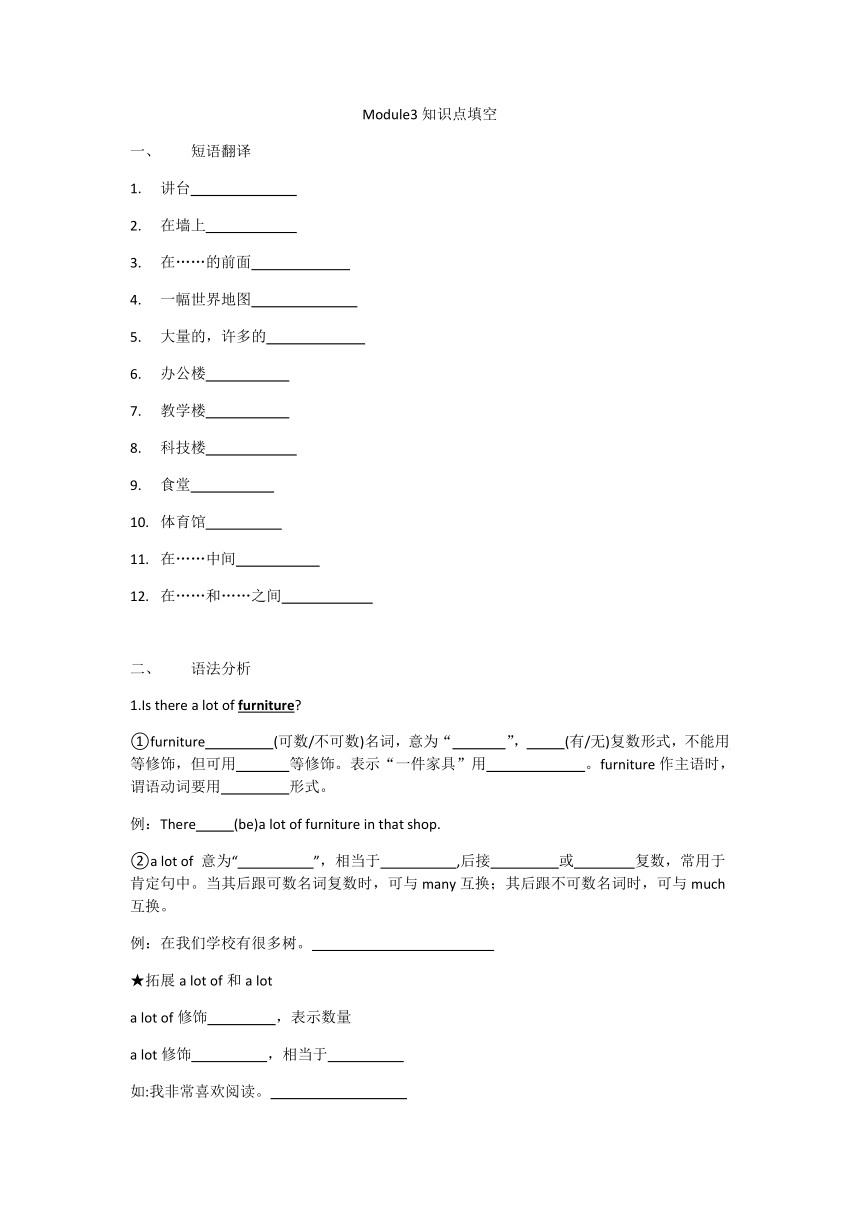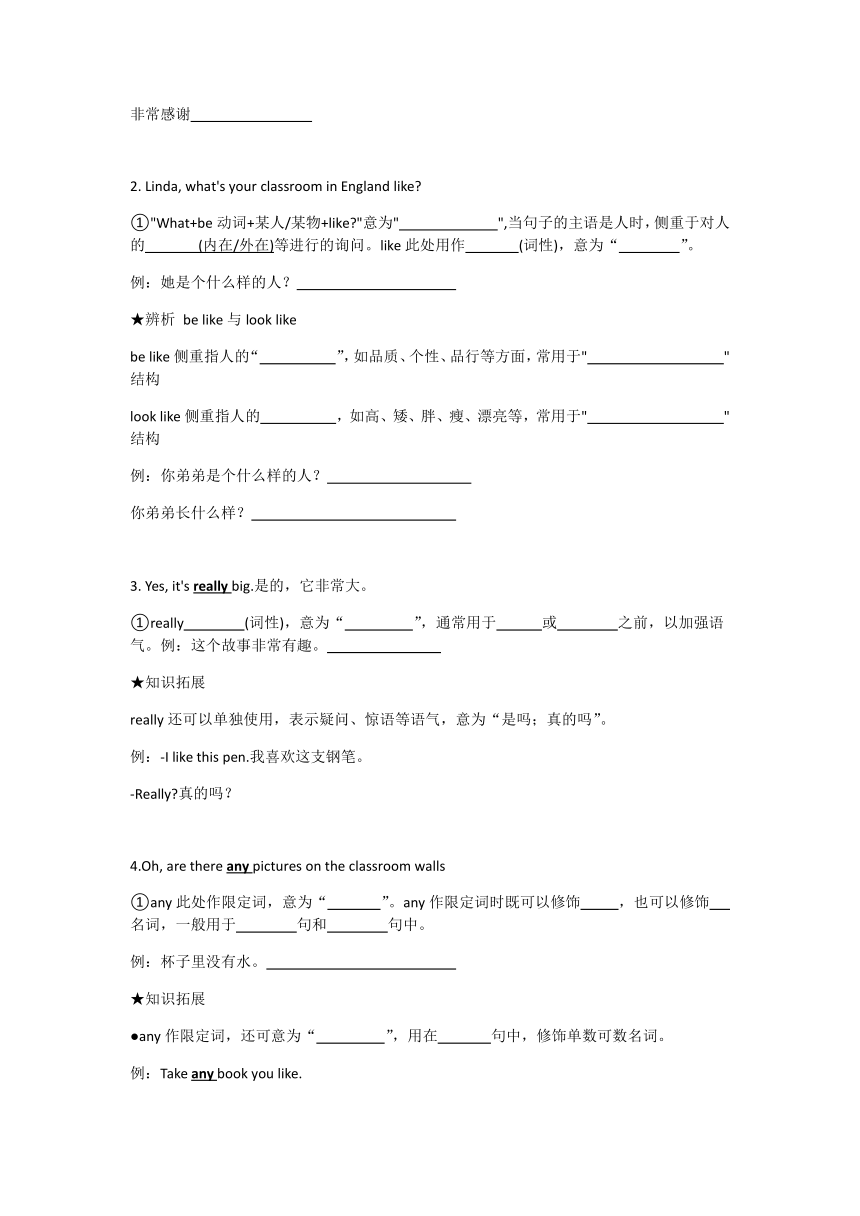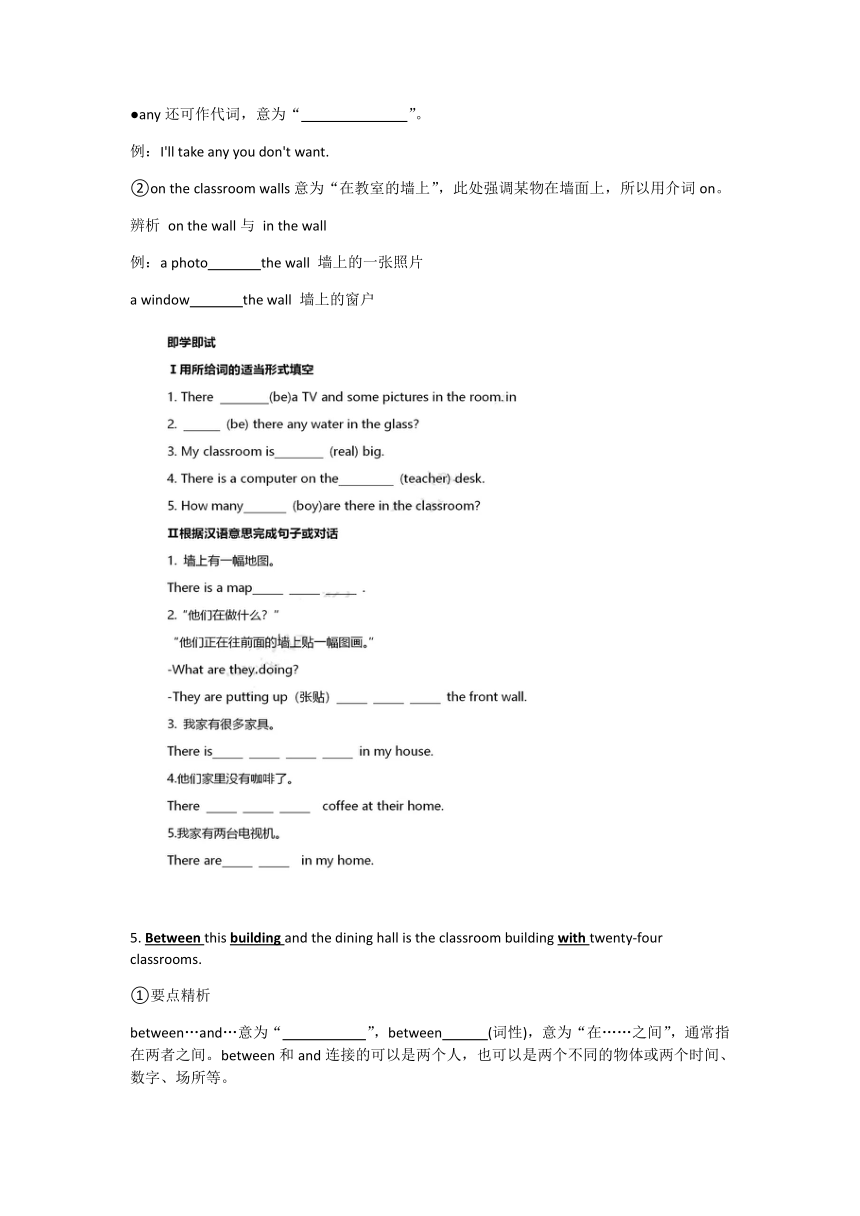外研版七年级上册Module 3 My school知识点填空(无答案)
文档属性
| 名称 | 外研版七年级上册Module 3 My school知识点填空(无答案) |  | |
| 格式 | docx | ||
| 文件大小 | 970.8KB | ||
| 资源类型 | 教案 | ||
| 版本资源 | 外研版 | ||
| 科目 | 英语 | ||
| 更新时间 | 2022-11-27 11:55:50 | ||
图片预览



文档简介
Module3知识点填空
短语翻译
讲台
在墙上
在……的前面
一幅世界地图
大量的,许多的
办公楼
教学楼
科技楼
食堂
体育馆
在……中间
在……和……之间
语法分析
1.Is there a lot of furniture
①furniture (可数/不可数)名词,意为“ ”, (有/无)复数形式,不能用 等修饰,但可用 等修饰。表示“一件家具”用 。furniture作主语时,谓语动词要用 形式。
例:There (be)a lot of furniture in that shop.
②a lot of 意为“ ”,相当于 ,后接 或 复数,常用于肯定句中。当其后跟可数名词复数时,可与many互换;其后跟不可数名词时,可与much互换。
例:在我们学校有很多树。
★拓展a lot of和a lot
a lot of修饰 ,表示数量
a lot修饰 ,相当于
如:我非常喜欢阅读。
非常感谢
2. Linda, what's your classroom in England like
①"What+be动词+某人/某物+like "意为" ",当句子的主语是人时,侧重于对人的 (内在/外在)等进行的询问。like此处用作 (词性),意为“ ”。
例:她是个什么样的人?
★辨析 be like与look like
be like侧重指人的“ ”,如品质、个性、品行等方面,常用于" "结构
look like侧重指人的 ,如高、矮、胖、瘦、漂亮等,常用于" "结构
例:你弟弟是个什么样的人?
你弟弟长什么样?
3. Yes, it's really big.是的,它非常大。
①really (词性),意为“ ”,通常用于 或 之前,以加强语气。例:这个故事非常有趣。
★知识拓展
really还可以单独使用,表示疑问、惊语等语气,意为“是吗;真的吗”。
例:-I like this pen.我喜欢这支钢笔。
-Really 真的吗?
4.Oh, are there any pictures on the classroom walls
①any此处作限定词,意为“ ”。any作限定词时既可以修饰 ,也可以修饰 名词,一般用于 句和 句中。
例:杯子里没有水。
★知识拓展
●any作限定词,还可意为“ ”,用在 句中,修饰单数可数名词。
例:Take any book you like.
●any还可作代词,意为“ ”。
例:I'll take any you don't want.
②on the classroom walls意为“在教室的墙上”,此处强调某物在墙面上,所以用介词on。
辨析 on the wall与 in the wall
例:a photo the wall 墙上的一张照片
a window the wall 墙上的窗户
5. Between this building and the dining hall is the classroom building with twenty-four classrooms.
①要点精析
between…and…意为“ ”,between (词性),意为“在……之间”,通常指在两者之间。between和and连接的可以是两个人,也可以是两个不同的物体或两个时间、数字、场所等。
例:
The shop opens 8 am 5 pm.
商店在上午8点到下午5点之间营业。
★小贴士
between后面跟代词时要用 形式。
例:between you and 在你和我之间
②要点精析
with (词性),此处意为“ ”,表示事物的特征或性质。介词短语 with twenty-four-classrooms在句中作后置定语,修饰 。
例:我想买一所带有四个卧室的房子。
★知识拓展
with作介词时,还意为“ ”,此时with构成的介词短语常位于句末作状语。
例:I often go to school with Mary.
③building (可数/不可数)名词,意为“建筑物”。
①知识拓展
building是由"动词 +-ing"构成的名词。类似的还有:
"会议,会见",
"开始,开端",
"写作",
"购物"等。
7. In front of the dining hall is the sports hall and the building in front of that is for science.
要点精析
for (词性),意为“ ”,表示某一目的或用途。
例:The room is for three people.这个房间供3个人住。
★知识拓展
for的其他用法:
①表示“ ”。
例:Thank you for your help.
②表示“ ”。
例:I run every morning for my health.
为了我的健康,我每天早晨跑步。
③表示“ ”。
例:It's time for Tom to go to school.
④表示“ ”。
例:He is leaving for Shanghai.
⑤表示“ ”,用于一段时间前。
例:I read English for an hour in the morning.
短语翻译
讲台
在墙上
在……的前面
一幅世界地图
大量的,许多的
办公楼
教学楼
科技楼
食堂
体育馆
在……中间
在……和……之间
语法分析
1.Is there a lot of furniture
①furniture (可数/不可数)名词,意为“ ”, (有/无)复数形式,不能用 等修饰,但可用 等修饰。表示“一件家具”用 。furniture作主语时,谓语动词要用 形式。
例:There (be)a lot of furniture in that shop.
②a lot of 意为“ ”,相当于 ,后接 或 复数,常用于肯定句中。当其后跟可数名词复数时,可与many互换;其后跟不可数名词时,可与much互换。
例:在我们学校有很多树。
★拓展a lot of和a lot
a lot of修饰 ,表示数量
a lot修饰 ,相当于
如:我非常喜欢阅读。
非常感谢
2. Linda, what's your classroom in England like
①"What+be动词+某人/某物+like "意为" ",当句子的主语是人时,侧重于对人的 (内在/外在)等进行的询问。like此处用作 (词性),意为“ ”。
例:她是个什么样的人?
★辨析 be like与look like
be like侧重指人的“ ”,如品质、个性、品行等方面,常用于" "结构
look like侧重指人的 ,如高、矮、胖、瘦、漂亮等,常用于" "结构
例:你弟弟是个什么样的人?
你弟弟长什么样?
3. Yes, it's really big.是的,它非常大。
①really (词性),意为“ ”,通常用于 或 之前,以加强语气。例:这个故事非常有趣。
★知识拓展
really还可以单独使用,表示疑问、惊语等语气,意为“是吗;真的吗”。
例:-I like this pen.我喜欢这支钢笔。
-Really 真的吗?
4.Oh, are there any pictures on the classroom walls
①any此处作限定词,意为“ ”。any作限定词时既可以修饰 ,也可以修饰 名词,一般用于 句和 句中。
例:杯子里没有水。
★知识拓展
●any作限定词,还可意为“ ”,用在 句中,修饰单数可数名词。
例:Take any book you like.
●any还可作代词,意为“ ”。
例:I'll take any you don't want.
②on the classroom walls意为“在教室的墙上”,此处强调某物在墙面上,所以用介词on。
辨析 on the wall与 in the wall
例:a photo the wall 墙上的一张照片
a window the wall 墙上的窗户
5. Between this building and the dining hall is the classroom building with twenty-four classrooms.
①要点精析
between…and…意为“ ”,between (词性),意为“在……之间”,通常指在两者之间。between和and连接的可以是两个人,也可以是两个不同的物体或两个时间、数字、场所等。
例:
The shop opens 8 am 5 pm.
商店在上午8点到下午5点之间营业。
★小贴士
between后面跟代词时要用 形式。
例:between you and 在你和我之间
②要点精析
with (词性),此处意为“ ”,表示事物的特征或性质。介词短语 with twenty-four-classrooms在句中作后置定语,修饰 。
例:我想买一所带有四个卧室的房子。
★知识拓展
with作介词时,还意为“ ”,此时with构成的介词短语常位于句末作状语。
例:I often go to school with Mary.
③building (可数/不可数)名词,意为“建筑物”。
①知识拓展
building是由"动词 +-ing"构成的名词。类似的还有:
"会议,会见",
"开始,开端",
"写作",
"购物"等。
7. In front of the dining hall is the sports hall and the building in front of that is for science.
要点精析
for (词性),意为“ ”,表示某一目的或用途。
例:The room is for three people.这个房间供3个人住。
★知识拓展
for的其他用法:
①表示“ ”。
例:Thank you for your help.
②表示“ ”。
例:I run every morning for my health.
为了我的健康,我每天早晨跑步。
③表示“ ”。
例:It's time for Tom to go to school.
④表示“ ”。
例:He is leaving for Shanghai.
⑤表示“ ”,用于一段时间前。
例:I read English for an hour in the morning.
同课章节目录
- Starte
- Module 1 My teacher and my friends
- Module 2 My English lesson
- Module 3 My English book
- Module 4 My everyday life
- Module 1 My classmates
- Unit 1 Nice to meet you.
- Unit 2 I'm Wang Lingling and I'm thirteen years ol
- Unit 3 Language in use.
- Module 2 My family
- Unit 1 Is this your mum?
- Unit 2 These are my parents.
- Unit 3 Language in use.
- Module 3 My school
- Unit 1 There are thirty students in my class.
- Unit 2 The library is on the left of the playgroun
- Unit 3 Language in use.
- Module 4 Healthy food
- Unit 1 We've got lots of apples.
- Unit 2 Is your food and drink healthy?
- Unit 3 Language in use.
- Module 5 My school day
- Unit 1 I love history.
- Unit 2 We start work at nine o'clock.
- Unit 3 Language in use.
- Revision module A
- Module 6 A trip to the zoo
- Unit 1 Does it eat meat?
- Unit 2 The tiger lives in Asia.
- Unit 3 Language in use.
- Module 7 Computers
- Unit 1 How do I write my homework on the computer?
- Unit 2 When do you use a computer?
- Unit 3 Language in use.
- Module 8 Choosing presents
- Unit 1 I always like birthday parties.
- Unit 2 She often goes to concerts.
- Unit 3 Language in use.
- Module 9 People and places
- Unit 1 We're enjoying the school trip a lot.
- Unit 2 They're waiting for buses or trains.
- Unit 3 Language in use.
- Module 10 Spring Festival
- Unit 1 Are you getting ready for Spring Festival?
- Unit 2 My mother's cleaning our houses and sweepin
- Unit 3 Language in use.
- Revision module B
